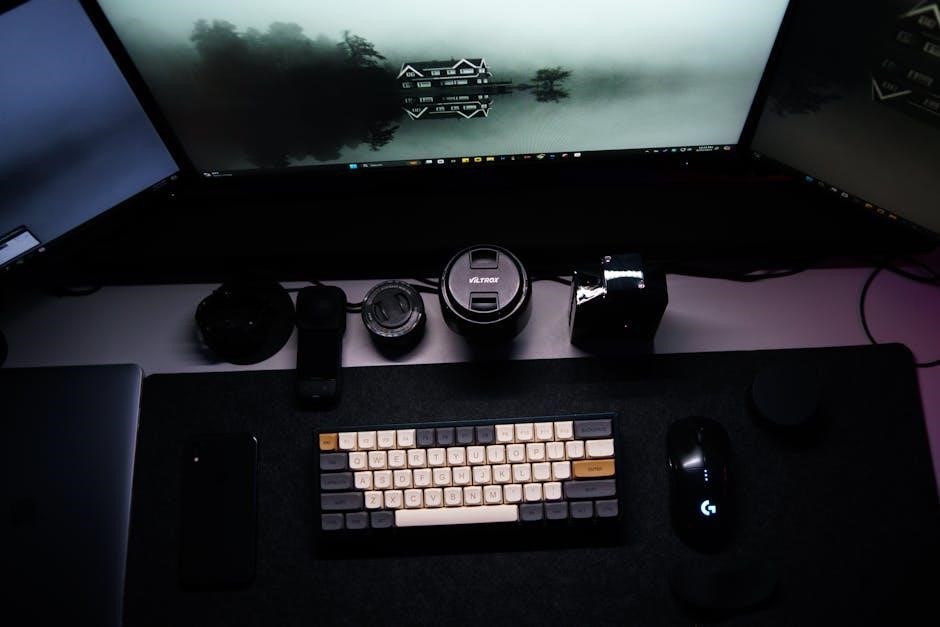Logitech H390 Headset Manual: A Comprehensive Guide
Welcome to the comprehensive guide for your Logitech H390 USB Headset! This manual provides everything you need, from initial setup and optimal fit adjustment to troubleshooting common issues and ensuring proper maintenance. Explore features like in-line controls and learn about software and driver updates.

The Logitech H390 USB headset is a popular choice for users seeking a reliable and comfortable audio solution for various applications, including video conferencing, online meetings, music listening, and gaming. Known for its plug-and-play simplicity, the H390 connects seamlessly to your computer via a USB-A port, eliminating the need for complex installation processes or additional software.
This headset features a noise-canceling microphone, ensuring clear voice transmission by reducing background distractions during calls. The in-line controls provide convenient access to volume adjustments and mute functionality, allowing for quick and easy management of your audio experience.
Designed with user comfort in mind, the H390 includes a padded headband and earcups, making it suitable for extended use. The adjustable headband ensures a secure and comfortable fit for a wide range of head sizes.
This comprehensive guide will walk you through every aspect of using your Logitech H390, from initial setup to advanced troubleshooting, ensuring you get the most out of your headset. Whether you’re a first-time user or looking to optimize your experience, this manual is your go-to resource. We’ll cover setup, adjustment, controls, troubleshooting, maintenance, and software updates.
Setting Up Your Logitech H390
Setting up your Logitech H390 headset is a straightforward process, thanks to its user-friendly design and plug-and-play functionality. This section will guide you through the necessary steps to get your headset up and running quickly and efficiently.
First, locate an available USB-A port on your computer. The H390 connects directly via USB, so no additional adapters or converters are needed. Once you’ve found an open port, simply plug the headset’s USB connector into it.
Your computer should automatically recognize the H390 as an audio device. In most cases, no additional drivers are required for basic functionality. However, for optimal performance and access to advanced features, it’s recommended to download and install the latest drivers from the Logitech website.
To ensure your computer is using the H390 for audio output and input, you may need to adjust your system’s audio settings. On Windows, navigate to the Sound settings in the Control Panel and select the H390 as the default playback and recording device. On macOS, you can find these settings in the Sound preferences.
Once the headset is connected and recognized, test the audio by playing music or making a test call. Adjust the volume using the in-line controls or your computer’s volume settings to achieve your desired sound level. If you encounter any issues, refer to the troubleshooting section for solutions.
Adjusting the Headset for Optimal Fit
Achieving a comfortable and secure fit with your Logitech H390 is crucial for extended use and optimal audio performance. A properly fitted headset not only enhances comfort but also ensures clear sound and effective noise cancellation.
The H390 features an adjustable headband, allowing you to customize the fit according to your head size and shape. To adjust the headband, gently slide the earcups up or down until the headset rests comfortably on your head. The goal is to find a position where the earcups sit snugly over your ears without applying excessive pressure.
Pay attention to the position of the earcups. They should fully cover your ears to create a seal that blocks out external noise and delivers immersive audio. If the earcups are too high or too low, you may experience sound leakage or discomfort.
The microphone boom is also adjustable, allowing you to position it for optimal voice capture. Gently rotate the boom to bring the microphone closer to your mouth. The ideal position is typically about two finger-widths away from your mouth.
Take the time to experiment with different adjustments until you find the most comfortable and secure fit. This will not only enhance your listening experience but also prevent discomfort during long periods of use. Remember to make small adjustments and test the fit frequently until you achieve the perfect balance. A well-fitted headset will significantly improve your overall experience with the Logitech H390.
Using the In-Line Controls
The Logitech H390 headset features convenient in-line controls that allow you to easily manage audio settings without having to access your computer’s sound controls. These controls provide quick access to essential functions such as volume adjustment and microphone muting.
The primary in-line control is the volume wheel, typically located on the cable connecting the headset to your computer. By rotating the wheel, you can increase or decrease the volume level to your desired setting. This allows you to quickly adjust the sound without interrupting your work or entertainment.
In addition to the volume wheel, the in-line controls also include a microphone mute button. Pressing this button instantly mutes the microphone, preventing others from hearing your voice. This is particularly useful during online meetings or calls when you need to temporarily silence your microphone.
The mute button often features an indicator light that illuminates when the microphone is muted, providing a visual cue to confirm the mute status. This helps prevent accidental broadcasting of unwanted audio.
The in-line controls are designed for ease of use, allowing you to quickly adjust audio settings without having to navigate through software menus or settings panels. This can be particularly useful during fast-paced gaming sessions or important conference calls.
Familiarizing yourself with the location and function of the in-line controls will enhance your overall experience with the Logitech H390 headset, providing convenient access to essential audio management features.

Troubleshooting Common Issues
Even with a reliable headset like the Logitech H390, users may occasionally encounter technical issues. This section outlines some common problems and provides troubleshooting steps to resolve them. Addressing these issues promptly can help maintain optimal headset performance.
One common issue is a malfunctioning microphone. If others cannot hear you, ensure the microphone is not muted via the in-line controls or computer settings. Verify that the microphone is properly positioned and not obstructed. Check your computer’s sound settings to confirm the H390 is selected as the default recording device.
Sound quality problems, such as distorted or low audio, can also occur. Ensure the volume is appropriately adjusted on both the headset and your computer. Check the audio settings on your computer and within the specific application you are using. Test the headset with another device to isolate the problem.
Another potential issue is the headset not being recognized by your computer. Verify that the USB connection is secure and try a different USB port. Restart your computer to refresh the device drivers. If the problem persists, reinstall the Logitech drivers or update them to the latest version.
By systematically addressing these common issues, users can often resolve problems with their Logitech H390 headset, ensuring uninterrupted audio communication.

Microphone Not Working
If you’re experiencing issues with your Logitech H390 microphone, several factors could be at play. Let’s explore the common causes and solutions to get your microphone working again.
First, ensure that the microphone is not physically muted. Check the in-line controls on the headset cable for a mute button and verify that it is not activated. The mute light may flash when the microphone is muted. Also, ensure the microphone boom is properly positioned close to your mouth.
Next, check your computer’s audio settings. In Windows, navigate to Sound settings and ensure that the Logitech H390 is selected as the default recording device. Verify that the microphone volume is not set too low or muted within these settings. Similar settings can be found on macOS under System Preferences > Sound > Input.
Driver issues can also cause microphone problems. Try uninstalling and reinstalling the Logitech H390 drivers from your computer’s Device Manager (Windows) or by downloading the latest drivers from the Logitech support website. Restarting your computer after reinstalling the drivers is recommended.
Finally, test the microphone with different applications to rule out application-specific issues. If the microphone works in some applications but not others, check the audio settings within the problematic application.
Sound Quality Problems
Experiencing poor sound quality with your Logitech H390 headset can be frustrating. Let’s explore common causes and solutions to enhance your audio experience.
First, ensure that the headset is properly connected to your computer’s USB port. Try a different USB port to rule out any port-related issues. Also, make sure the headset volume is adjusted appropriately using the in-line controls.
Check your computer’s audio settings to ensure that the Logitech H390 is selected as the default playback device. Verify that the volume levels are not set too low or muted within these settings. In Windows, navigate to Sound settings, and on macOS, go to System Preferences > Sound > Output.
Driver issues can also impact sound quality. Try uninstalling and reinstalling the Logitech H390 drivers from your computer’s Device Manager (Windows) or by downloading the latest drivers from the Logitech support website. Restarting your computer after reinstalling the drivers is recommended.
Interference from other electronic devices can sometimes cause audio distortion. Try moving the headset and USB cable away from other devices, such as routers or mobile phones.
Finally, test the headset with different audio sources to rule out source-specific issues. If the sound quality is poor with some sources but not others, check the audio settings of the problematic source.
Headset Not Recognized by Computer
If your computer isn’t recognizing your Logitech H390 headset, it can disrupt your work or entertainment. Here’s a systematic approach to troubleshoot this issue.
Begin by physically inspecting the USB connection. Ensure the headset’s USB connector is firmly plugged into your computer’s USB port. Try using a different USB port, as the initial one may be faulty. Also, avoid connecting through USB hubs or extension cables, as these can sometimes interfere with device recognition.
Check your computer’s Device Manager (Windows) or System Information (macOS) to see if the headset is listed. If it appears with a yellow exclamation mark or as an unknown device, it indicates a driver issue.
To resolve driver problems, try uninstalling the device from the Device Manager and then restarting your computer. Windows will usually attempt to reinstall the drivers automatically. Alternatively, download the latest drivers for the Logitech H390 from the official Logitech support website and install them manually.
Ensure that your operating system is up to date. Sometimes, outdated operating systems can cause compatibility issues with new hardware.
If the issue persists, test the headset on another computer to determine if the problem lies with the headset itself or with your computer. If the headset is still not recognized, it may indicate a hardware failure, and you may need to contact Logitech support for assistance.
Cleaning and Maintenance
Proper cleaning and maintenance are crucial for prolonging the life and maintaining the hygiene of your Logitech H390 headset. Regular cleaning prevents the buildup of dirt, oils, and debris that can affect sound quality and comfort.
Before cleaning, always disconnect the headset from your computer. Use a soft, lint-free cloth slightly dampened with water to gently wipe down the headset’s surfaces, including the earcups, headband, and microphone boom. Avoid using excessive moisture, as it can damage the internal components.
For stubborn dirt or grime, you can use a mild, diluted soap solution. Apply the solution to the cloth, not directly to the headset, and gently wipe the affected areas; Ensure you wipe away any soap residue with a clean, damp cloth.
Pay special attention to the earcups, as they come into direct contact with your skin. If your headset has removable earcups, consider washing them separately according to the manufacturer’s instructions.
The microphone can also accumulate dust and debris. Use a soft brush or compressed air to gently clean the microphone opening.
Avoid using harsh chemicals, solvents, or abrasive cleaners, as these can damage the headset’s materials and finish.
When not in use, store your headset in a clean, dry place away from direct sunlight and extreme temperatures. This will help prevent damage and prolong its lifespan. Consider using a headset stand or case for added protection. Regular maintenance will ensure your Logitech H390 headset remains in good condition and provides optimal performance for years to come.
Software and Driver Updates
Keeping your Logitech H390 headset’s software and drivers up-to-date is essential for optimal performance and compatibility. Updated drivers often include bug fixes, performance improvements, and new features that can enhance your headset experience.
To ensure your headset is running the latest software, visit the official Logitech support website. Navigate to the H390 product page and look for the “Downloads” or “Support” section. Here, you’ll find the most recent drivers and software available for your operating system.
Download the appropriate driver for your version of Windows or macOS. Before installing the new driver, it’s recommended to uninstall the previous version to avoid conflicts. You can do this through the “Device Manager” in Windows or by dragging the application to the trash on macOS.
Once the old driver is uninstalled, run the downloaded installer and follow the on-screen instructions. After the installation is complete, restart your computer to ensure the new driver is properly loaded.
In some cases, Logitech may provide additional software for customizing your headset settings, such as equalizer adjustments or microphone enhancements. Be sure to download and install this software as well if available.
Regularly check the Logitech support website for new updates to keep your headset performing at its best. By maintaining up-to-date software and drivers, you can avoid compatibility issues and enjoy a seamless audio experience with your Logitech H390 headset. This proactive approach enhances functionality and extends the lifespan of your device.
Downloading the Correct Drivers
Ensuring you download and install the correct drivers for your Logitech H390 headset is crucial for its proper functionality. The process begins by identifying your computer’s operating system, whether it’s Windows (various versions like Windows 10, 11, or older versions) or macOS. This information is essential because drivers are OS-specific.
Visit the official Logitech support website and navigate to the H390 headset’s product page. Here, you’ll typically find a “Downloads” section. The website often automatically detects your operating system, but it’s always best to verify the selection manually to avoid any errors.
If the website doesn’t automatically detect your OS, you’ll likely find a dropdown menu or a list of operating systems to choose from. Select the one that matches your computer. After selecting the correct OS, the website will display the available drivers and software for your H390.
Download the driver specifically designed for your headset. Be cautious of third-party websites offering drivers, as they may contain malware or incompatible files. Always prioritize downloading directly from Logitech’s official website.
Once the driver file is downloaded, locate it on your computer and run the installer. Follow the on-screen instructions to complete the installation process. After installation, it’s generally recommended to restart your computer to ensure the new driver is properly loaded and functioning. This ensures seamless integration and optimal performance of your Logitech H390 headset.
Where to Find the Official Manual
Logitech Support and Resources
Logitech offers a comprehensive suite of support and resources to assist users with their H390 headset. For immediate assistance, the Logitech support website is the primary hub. Here, you can find FAQs, troubleshooting guides, and downloadable software and drivers, ensuring your headset functions optimally.
The support website also features a robust knowledge base, addressing common issues and providing step-by-step solutions. This is a valuable resource for resolving problems independently. If the knowledge base doesn’t address your specific concern, Logitech provides options to contact their support team directly.
You can typically reach Logitech support via email, live chat, or phone. The availability of these options may vary depending on your region. When contacting support, be sure to have your headset’s model number (H390) and any relevant information about the issue you’re experiencing. This will help the support team diagnose and resolve your problem more efficiently.
In addition to direct support, Logitech’s online community forums can be a valuable resource. Here, you can connect with other H390 users, share experiences, and seek advice from experienced community members. Logitech also provides product manuals and documentation on their website, offering detailed information about your headset’s features and functionality. These resources combined ensure users have access to ample assistance.

